New Bedford Whaling National Historical Park
Sunday, November 5, 2006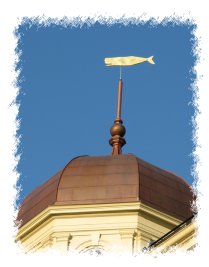 Undoubtedly casting an envious eye toward its nearby neighbor of Mystic Seaport, a few years ago the good folk of New Bedford decided to do something about its rundown waterfront district. New Bedford and Nantucket Island were the center of the American whaling industry, and at one point New Bedford boasted the highest per capita income in the US. Whaling was good to New Bedford until over harvesting destroyed first the right whale, then humpback, sperm and finally bowhead whale populations.
Undoubtedly casting an envious eye toward its nearby neighbor of Mystic Seaport, a few years ago the good folk of New Bedford decided to do something about its rundown waterfront district. New Bedford and Nantucket Island were the center of the American whaling industry, and at one point New Bedford boasted the highest per capita income in the US. Whaling was good to New Bedford until over harvesting destroyed first the right whale, then humpback, sperm and finally bowhead whale populations.Adding insult to injury, the Whaleship Charles W. Morgan, the centerpiece of the Mystic Seaport collection, was built in New Bedford. The only surviving American whaler, the city of New Bedford actually sold the ship to Mystic about 50 years ago. This shortsighted decision came back to haunt New Bedford, as Mystic thrived, and the New Bedford waterfront slid into urban blight.
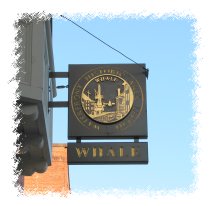 Then WHALE came along. The organization (Waterfront Historic Area League) was created to help restore and revitalize the old whaling district. The crown jewel of this effort is the New Bedford Whaling Museum. Several years ago the National Park Service got involved, and the New Bedford Whaling National Historical Park was created. The park, which covers several square blocks, includes the still active waterfront, and numerous public and privately owned structures. The Visitors Center is housed in a building that started its life as a bank, and later became a courthouse (and an auto parts store!) . It’s a beautiful building, and the Park Service put a lot of effort into the restoration to it’s original look.
Then WHALE came along. The organization (Waterfront Historic Area League) was created to help restore and revitalize the old whaling district. The crown jewel of this effort is the New Bedford Whaling Museum. Several years ago the National Park Service got involved, and the New Bedford Whaling National Historical Park was created. The park, which covers several square blocks, includes the still active waterfront, and numerous public and privately owned structures. The Visitors Center is housed in a building that started its life as a bank, and later became a courthouse (and an auto parts store!) . It’s a beautiful building, and the Park Service put a lot of effort into the restoration to it’s original look.Today the district is well on its way to revival – in additional to the museum, buildings owned by the Park Service and WHALE, many restaurants, galleries, and nautical related businesses have moved in. Some of the old structures are still in need of tenants, but overall the restoration effort is going well.
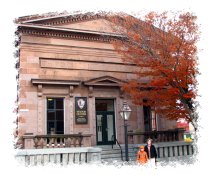 We started at the Visitors Center, picking up the Jr. Ranger booklet for Vance. The required portion of the book was largely organized as a scavenger hunt which required us to walk around the historic district looking for clues. The information needed for the activities was usually provided on the information signs outside of the buildings. For example, there were questions about customs activities and duties which could be found on the sign outside the Customs house. There were also some fun things to find like a sundial on the side of a building, and a whale wind vane.
We started at the Visitors Center, picking up the Jr. Ranger booklet for Vance. The required portion of the book was largely organized as a scavenger hunt which required us to walk around the historic district looking for clues. The information needed for the activities was usually provided on the information signs outside of the buildings. For example, there were questions about customs activities and duties which could be found on the sign outside the Customs house. There were also some fun things to find like a sundial on the side of a building, and a whale wind vane.One of the optional Jr. Ranger activities included learning how to read nautical flags. The waterfront visitors center (which was closed for the season) had flags which spelled “Welcome Visitors Center” when you decoded them. We also had to find a ‘harpoon fence’. We had just about given up on this when we found it at our last stop on the waterfront.
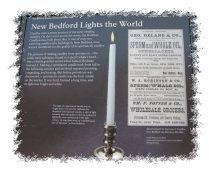 The Whaling Museum is a large, modern museum. It has a very well done film, presented by the Park Service, titled ‘Lighting the World’. Whale oil was used for lighting, burning far cleaner and brighter than other fuels of the day. Ambergris from the whale’s stomach was used to make perfume, and was worth literally more than its weight in gold. Finally, baleen from the mouth of the Bowhead Whale was used to make women’s corsets. While risky, whaling could be a highly profitable venture for a ships owners and backers.
The Whaling Museum is a large, modern museum. It has a very well done film, presented by the Park Service, titled ‘Lighting the World’. Whale oil was used for lighting, burning far cleaner and brighter than other fuels of the day. Ambergris from the whale’s stomach was used to make perfume, and was worth literally more than its weight in gold. Finally, baleen from the mouth of the Bowhead Whale was used to make women’s corsets. While risky, whaling could be a highly profitable venture for a ships owners and backers.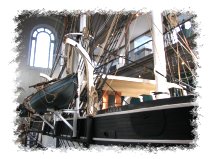 One of the most unusual and interesting exhibits is the model of the Whaleship Lagoda. As the whaling industry was in sharp decline, an heiress of one of the fleet owners commissioned a ½ size model of one of her father’s most successful ships, the Lagoda. The model was constructed by the same shipwrights that built the Lagoda and other whalers. She also built a building to house the model, which is today part of the Whaling museum. You can walk around the model (you have to duck some in a few places), and it is accompanied by one of the best information kiosks I’ve ever seen. The kiosk explains in great detail the purpose of different portions of the ship, and how the whaling process would work – from catching the whales, to harvesting and rendering the oil from the whale blubber. We also viewed a narrated film on whaling, which used footage from the movie ‘Down to the Sea in Ships’, which was filmed on the Whaleship Voyager, the last whaler to sail from New Bedford.
One of the most unusual and interesting exhibits is the model of the Whaleship Lagoda. As the whaling industry was in sharp decline, an heiress of one of the fleet owners commissioned a ½ size model of one of her father’s most successful ships, the Lagoda. The model was constructed by the same shipwrights that built the Lagoda and other whalers. She also built a building to house the model, which is today part of the Whaling museum. You can walk around the model (you have to duck some in a few places), and it is accompanied by one of the best information kiosks I’ve ever seen. The kiosk explains in great detail the purpose of different portions of the ship, and how the whaling process would work – from catching the whales, to harvesting and rendering the oil from the whale blubber. We also viewed a narrated film on whaling, which used footage from the movie ‘Down to the Sea in Ships’, which was filmed on the Whaleship Voyager, the last whaler to sail from New Bedford.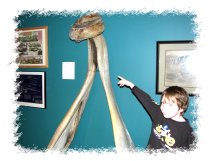 The museum has a skeleton of a adolescent sperm whale that had beached itself on Nantucket Island. This is surrounded by a lot of exhibits about the sperm whale. Vance learned that sperm whales can dive to a depth of 2 miles, a fact that he’ll be happy to tell you if you give him half a chance ;-) There was also an interesting display of a deformed jawbone, where the lower jaw had wrapped around itself several times. According to the docent, this was not all that uncommon for the whalers to find, and indeed, in Moby Dick the great sperm way is described as having a ‘crooked jaw’.
The museum has a skeleton of a adolescent sperm whale that had beached itself on Nantucket Island. This is surrounded by a lot of exhibits about the sperm whale. Vance learned that sperm whales can dive to a depth of 2 miles, a fact that he’ll be happy to tell you if you give him half a chance ;-) There was also an interesting display of a deformed jawbone, where the lower jaw had wrapped around itself several times. According to the docent, this was not all that uncommon for the whalers to find, and indeed, in Moby Dick the great sperm way is described as having a ‘crooked jaw’.Speaking of Moby Dick, New Bedford is prominently mentioned in the book and movie. Herman Melville sailed from New Bedford on a whaler at age 21 (although he later jumped ship in the Pacific), and he drew from this experience to write Moby Dick. The story of Moby Dick was inspired by the real life adventures of the Whaleship Essex, which was rammed and sunk by a sperm whale in the middle of the Pacific Ocean.
The story of the Essex and its crew is told in a wonderful book by Nathaniel Philbrick, ‘In the Heart of the Sea”. After the ship is sunk, members of the crew survive in whaleboats for over 3 months before being rescued. Fearing cannibals, they avoid sailing to nearby islands, instead preferring to attempt a 1000+ mile voyage against the winds and current to South America. The irony lies in the fact they ultimately had to resort to cannibalism themselves to survive. It’s an amazing story, and it’s one of those hard to put down reads, winning a National Book Award. Philbrick, who is rapidly becoming one of our favorite historians, also wrote a child appropriate version of the story called ‘Revenge of the Whale’, which we’ve picked up for Vance to read. Philbrick is also the author of “Sea of Glory”, an account of the largely forgotten U.S. Exploring Expedition which discovered Antarctica, and the recently released ‘Mayflower’, which I read shortly after visiting Plimoth Plantation.
We missed meeting Philbrick at a book signing for “Mayflower” by just a couple of days at the Whaling Museum. The Museum was celebrating the 50th anniversary of the premiere of the movie “Moby Dick”, and Philbrick was to be one of the featured speakers for the event. Vance has been reading a children’s version of Moby Dick, so we decided to treat ourselves with the DVD of the movie, starring Gregory Peck.
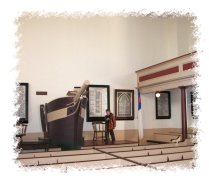 Across the street from the Whaling Museum is the Seaman’s Bethel, a mariner’s church. If you’ve ever seen the movie of Moby Dick, this is where Orson Wells delivers a thundering sermon from a pulpit that looks like the bow of a ship. This feature didn’t originally exist in the Bethel, but after the movie came out, so many people asked about it that one was built into the chapel!
Across the street from the Whaling Museum is the Seaman’s Bethel, a mariner’s church. If you’ve ever seen the movie of Moby Dick, this is where Orson Wells delivers a thundering sermon from a pulpit that looks like the bow of a ship. This feature didn’t originally exist in the Bethel, but after the movie came out, so many people asked about it that one was built into the chapel!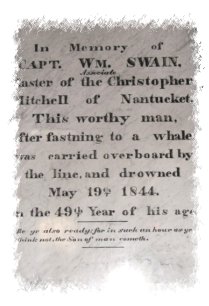 The Seaman’s Bethel is a sobering place - all along the walls are memorial plaques for sailors from New Bedford who have been lost at sea. There are instances of sailors killed while hunting whale and those lost in more recent times. These memorials illustrate the dangers of the sea – on average, New Bedford loses about 3 fishermen per year to the ocean.
The Seaman’s Bethel is a sobering place - all along the walls are memorial plaques for sailors from New Bedford who have been lost at sea. There are instances of sailors killed while hunting whale and those lost in more recent times. These memorials illustrate the dangers of the sea – on average, New Bedford loses about 3 fishermen per year to the ocean.With the focus on a specific industry, the New Bedford NHP differentiated itself from other maritime locations we had visited. We learned the process of catching whales, how the whale was cut up, how the blubber was rendered into oil, and what the oil was used for. This was a nice tie-in with Moby Dick for Vance, and also prepped us for our next stop in Mystic Seaport, where we could tour a real whaling ship, the Charles W. Morgan. Too bad New Bedford didn’t hang onto it…..

Vance: New Bedford was once called “The City That Lit The World.” First we went to the Whaling Museum. The whalers hunted Sperm whales, Bowhead whales, and Blue whales. We used to use whale oil from the blubber to light lamps. Whaling ships had little prisms to let in light for the crew at night, though it offered very little light. One man, Herman Melville, wrote a whaling novel, Moby Dick.
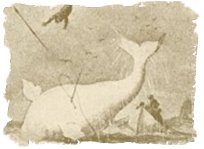 I have seen the movie and read the book. Moby Dick is about a white Sperm whale that the captain wants to kill because it bit off his leg. Sperm whales are one of the three species of whale to have teeth. The other two whales that have teeth are the Killer whale and the Beluga whale. Sperm whales can dive over 2 miles deep. They go down that deep because they like to eat the giant squids.
I have seen the movie and read the book. Moby Dick is about a white Sperm whale that the captain wants to kill because it bit off his leg. Sperm whales are one of the three species of whale to have teeth. The other two whales that have teeth are the Killer whale and the Beluga whale. Sperm whales can dive over 2 miles deep. They go down that deep because they like to eat the giant squids.AMAZING, A SMALL TOWN LIT THE WORLD!
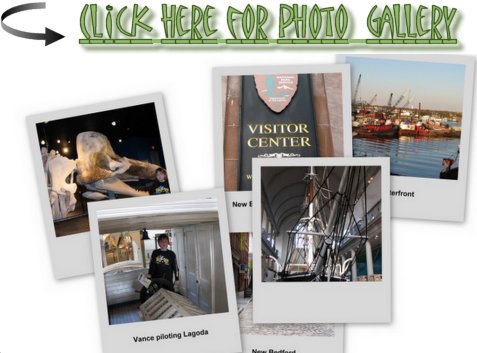







<< Home